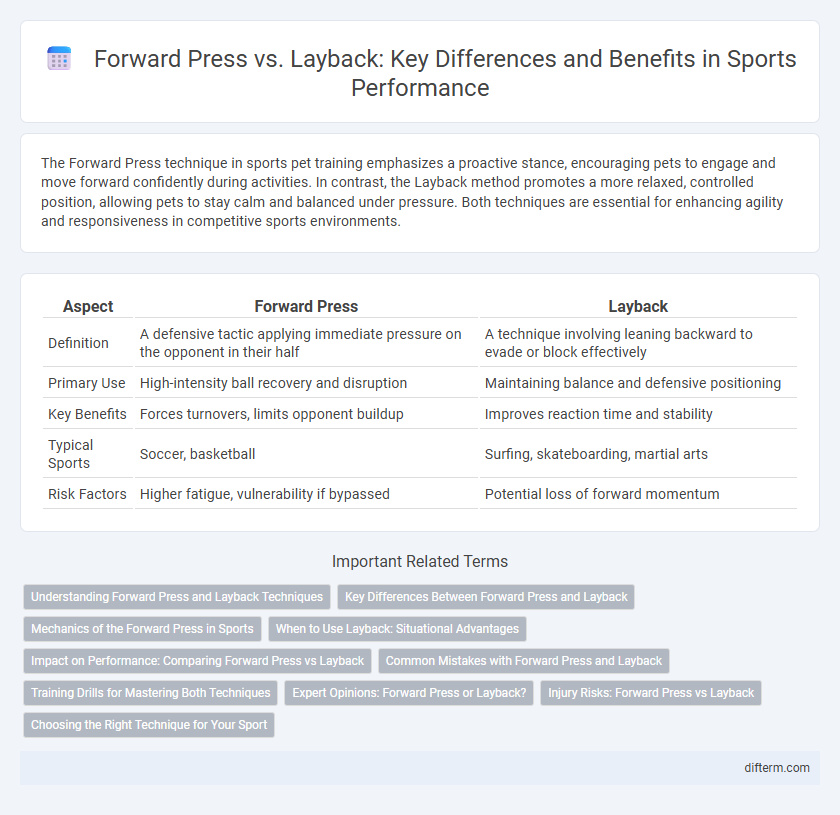The Forward Press technique in sports pet training emphasizes a proactive stance, encouraging pets to engage and move forward confidently during activities. In contrast, the Layback method promotes a more relaxed, controlled position, allowing pets to stay calm and balanced under pressure. Both techniques are essential for enhancing agility and responsiveness in competitive sports environments.
Table of Comparison
| Aspect | Forward Press | Layback |
|---|---|---|
| Definition | A defensive tactic applying immediate pressure on the opponent in their half | A technique involving leaning backward to evade or block effectively |
| Primary Use | High-intensity ball recovery and disruption | Maintaining balance and defensive positioning |
| Key Benefits | Forces turnovers, limits opponent buildup | Improves reaction time and stability |
| Typical Sports | Soccer, basketball | Surfing, skateboarding, martial arts |
| Risk Factors | Higher fatigue, vulnerability if bypassed | Potential loss of forward momentum |
Understanding Forward Press and Layback Techniques
Forward Press emphasizes aggressive body positioning by leaning into the opponent to maintain pressure, enhancing control and balance during a match. Layback technique involves a defensive backward lean to create space, disrupt the opponent's rhythm, and prepare for counterattacks. Mastery of these techniques improves tactical versatility and effectiveness in close-quarters combat within sports like wrestling or Brazilian Jiu-Jitsu.
Key Differences Between Forward Press and Layback
Forward press in sports emphasizes aggressive forward momentum and active engagement, often used to apply pressure and control the pace of the game. Layback relies on a defensive posture, creating space and opportunity through strategic retreat and counter-attacks. Key differences include the forward press's focus on proactive dominance versus the layback's emphasis on patience and reactive positioning.
Mechanics of the Forward Press in Sports
The mechanics of the Forward Press in sports involve a controlled forward lean of the upper body to increase power output and maintain balance during dynamic movements. This technique engages the core and lower body muscles to generate force while allowing for rapid directional changes. Proper execution of the Forward Press improves speed, stability, and efficiency in athletic performance.
When to Use Layback: Situational Advantages
Layback is ideal when executing sharp turns on steep slopes, providing enhanced edge grip and control in challenging terrain. This technique maximizes stability during high-speed descents and tight curves by shifting body weight backward, reducing the risk of catching an edge. Athletes often prefer layback in variable snow conditions or when navigating moguls to maintain balance and precision.
Impact on Performance: Comparing Forward Press vs Layback
Forward press enhances power output by engaging core and upper body muscles more dynamically, leading to improved acceleration and shot strength in sports like kayaking and cycling. Layback technique optimizes endurance by promoting better breathing mechanics and reducing muscular fatigue, which supports sustained performance during prolonged activities. Choosing between forward press and layback depends on the sport-specific demands for explosive power versus energy conservation.
Common Mistakes with Forward Press and Layback
Common mistakes in forward press include improper foot placement and leaning too far forward, causing loss of balance and reduced power. In layback, athletes often fail to maintain a tight core, resulting in insufficient extension and compromised stability during execution. Correct technique demands precise body alignment and controlled movement to maximize performance and prevent injury.
Training Drills for Mastering Both Techniques
Training drills for mastering Forward Press and Layback techniques emphasize core strength, balance, and precision timing. Forward Press requires dynamic resistance band exercises and plyometric push-ups to build explosive upper body power, while Layback benefits from flexibility routines and partner-assisted lean-back drills to enhance spinal extension and control. Incorporating mirror drills and video analysis helps athletes refine biomechanics and transition smoothly between both maneuvers.
Expert Opinions: Forward Press or Layback?
Expert opinions in sports often weigh the effectiveness of the Forward Press versus Layback based on situational dynamics and player skill sets. The Forward Press is praised for applying aggressive pressure, enhancing ball control and quick transitions during fast breaks. Conversely, the Layback technique is favored for its stability and strategic defense, allowing players to maintain position while executing counterattacks with precision.
Injury Risks: Forward Press vs Layback
Forward press in sports can increase the risk of wrist and shoulder injuries due to the intense forward weight bearing and dynamic range of motion involved. Layback positions place significant strain on the lumbar spine and hips, heightening the chances of lower back strains and groin pulls. Athletes should assess their flexibility and strength to minimize injury risks associated with each technique.
Choosing the Right Technique for Your Sport
Forward press offers aggressive ball control and quick offensive maneuvers ideal for fast-paced sports like basketball and soccer, enhancing forward momentum and scoring opportunities. Layback emphasizes defensive stability and body positioning, preferred in contact sports such as rugby and American football to maintain balance against opposing forces. Selecting the right technique depends on the sport's speed, contact level, and positional demands, optimizing performance through specific biomechanical advantages.
Forward Press vs Layback Infographic

 difterm.com
difterm.com